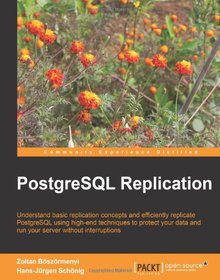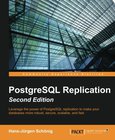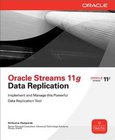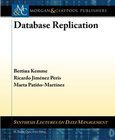PostgreSQL Replication

Book Details:
| Publisher: | Packt Publishing |
| Series: | Packt |
| Author: | Zoltan Boszormenyi |
| Edition: | 1 |
| ISBN-10: | 1849516723 |
| ISBN-13: | 9781849516723 |
| Pages: | 250 |
| Published: | Aug 26 2013 |
| Posted: | Nov 19 2014 |
| Language: | English |
| Book format: | |
| Book size: | 13.57 MB |
Book Description:
Understand basic replication concepts and efficiently replicate PostgreSQL using high-end techniques to protect your data and run your server without interruptions Overview Explains the new replication features introduced in PostgreSQL 9 Contains easy to understand explanations and lots of screenshots that simplify an advanced topic like replication Teaches PostgreSQL administrators how to maintain consistency between redundant resources and to improve reliability, fault-tolerance, and accessibility In Detail PostgreSQL offers a comprehensive set of replication related features, which can be used to make your database servers more robust and way more scalable. Unleashing the power of PostgreSQL provides the user with countless opportunities and a competitive advantage over other database systems. To make things more powerful, PostgreSQL can be used in conjunction with a handful of sophisticated tools serving various different needs such as queuing, logical replication, or simplified transaction log handling. "PostgreSQL Replication" is a practical, hands-on guide to PostgreSQL replication. It will provide you with the theoretical background as well as simple examples showing you how to make replication work on your system. A broad toolchain will be presented along with mature PostgreSQL-core technology. "PostgreSQL Replication" starts with an introduction to replication concepts as well as the physical limitations of different replication solutions. You will be guided through various techniques such as Point-In-Time-Recovery, transaction-log-based replication and you will be introduced to a set of replication-related tools. In the final chapter you will learn to scale PostgreSQL to many different servers using PL/Proxy. You will learn how to reset PostgreSQL to a certain point in time and figure out how to replicate data in many ways. You will deal with both synchronous as well as asynchronous replication. In addition to that, the book covers important topics, such as Slony, and upgrades with virtually no downtime. We will also cover important performance-related topics to make sure your database setups will provide you with high speed AND high availability. "PostgreSQL Replication" contains all the information you need to design and operate replicated setups. You will learn everything you need to know for your daily work and a lot more. What you will learn from this book Recover a PostgreSQL database to a certain point in time Set up asynchronous and synchronous streaming replication Handle transaction log files efficiently Learn about Linux High Availability Get to grips with Slony replication Get PL/Proxy to scale infinitely Understand pgpool and pgbouncer to improve speed and reliability Perform fast on-the-fly backups Increase reliability and throughput Improve data security and geographically distribute data Approach This book has a chapter dedicated to each aspect of replication. The new features of PostgreSQL 9 are introduced and there are lots of practical examples and screenshots.
Download Link:
Related Books:
Oracle Streams 11g
Data Replication
Master Oracle Streams 11g Replication Enable real-time information access and data sharing across your distributed framework using the expert information in this Oracle Press guide. Oracle Streams 11g Data Replication explains how to set up and administer a unified enterprise data sharing infrastructure. Learn how to capture, propagate, and apply database changes, transform data, and handle data conflicts. Monitoring, optimizing, and troubleshooting techniques are also covered in this comprehensive volume. Understand Oracle Streams components and architecture Gain in-depth knowledge about capturing, propagating, and applying data manipulation language (DML) and data definition language (DDL) changes Learn how to access and modify the contents of Lo...
Database Replication
Database replication is widely used for fault-tolerance, scalability and performance. The failure of one database replica does not stop the system from working as available replicas can take over the tasks of the failed replica. Scalability can be achieved by distributing the load across all replicas, and adding new replicas should the load increase. Finally, database replication can provide fast local access, even if clients are geographically distributed clients, if data copies are located close to clients. Despite its advantages, replication is not a straightforward technique to apply, and there are many hurdles to overcome. At the forefront is replica control: assuring that data copies remain consistent when updates occur. There exist many altern...
2007 - 2021 © eBooks-IT.org



